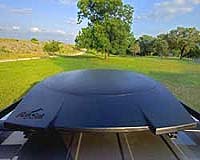 |
Berlin, Germany (SPX) Oct 12, 2010 Manfred Zink likes to organise things. For the TanDEM-X radar satellite mission he is organising when and where the antennas of the satellites are to point, in order to acquire the best three-dimensional images possible of our planet. Manfred Zink is Project Manager for the Ground Segment of the mission at the German Aerospace Center in Oberpfaffenhofen. He is responsible for directing the entire mission, from the close flight formation of the TerraSAR-X and TanDEM-X satellites to the creation of the digital elevation model. This is the thirteenth of our series of portraits on the DLR web portal. One look at his desk is enough to see where the 47-year-old physicist's heart is. To the left side, close to the window, are photos of his family, at the other end are miniature models of the TerraSAR-X and TanDEM-X satellites. The actual satellites have been orbiting Earth together since June 2010, and from October 2010 they will be flying with each other in a close helical path to scan Earth's surface from different viewing angles using their radars.
Butterflies in the stomach "I've got butterflies in my stomach. No one has ever flown two satellites so close to each other before. The control system is very complicated and we have to be precise to the last decimal point. After all, neither of the two satellites knows that the other is there, so to speak. It's especially difficult to match the two radar systems to one another and keep them synchronised," he explains. During a radar imaging series, the two satellites exchange synchronisation signals ten times a second, and everything has to be set up correctly in advance. This is the only way can we obtain precise and state-of-the-art elevation models of Earth's surface. "We have to go right to the edge of the envelope" For these images, the satellites are operating in bistatic mode. One satellite sends out a radar signal, but both receive the reflection from the Earth's surface. The aim of the TanDEM-X mission is to map the entire Earth's surface in three dimensions - a total of 150 million square kilometres. This data will be the foundation for a series of applications, from environmental research to the development of advanced navigation systems. Manfred Zink has to push the radar systems to the limit to achieve this. "The challenge is in going right to the edge of our envelope. For example, the imaging cycles usually last three minutes per orbit. The time window is limited, because the satellites heat up quickly when the radar is operating. But to create our digital elevation model, we have to run the satellites for another 30 seconds. We're able to do this because we've modelled the thermal budget of the satellites very precisely."
The road to DLR The Austrian packed his bags and soon found his place at DLR - in 1991 he won the DLR Science Prize (Wissenschaftspreis), and received his doctorate two years later. But he didn't settle down. A specialist in radar system calibration like Zink is always on the move - whether visiting the European Space Agency (ESA) in Holland and Italy or NASA in the USA.
Unforgettable experience The remote sensing mission lasted 11 tense days. The aim was to map around 80 percent of Earth's surface in 3D, similar to the current DLR TanDEM-X mission. During the SRTM mission, the second antenna was mounted at the end of a 60-metre long deployable mast on the shuttle, while DLR is using two nearly identical satellites. Both missions employ SAR (synthetic aperture radar), which can acquire imaging data regardless of cloud cover or the availability of daylight.
Always one more dream ahead "I have great memories from my years at ESA and collaboration at Houston. But it's great to be back home - with my family and a real dream project," he says. What could be better than this? "This close formation flight is a real milestone. There's no doubt about it." But he's already looking ahead, "We could go one step further than TanDEM-X - with a Tandem-L mission, two low frequency radar satellites, flying in close formation." This would enable scientists to observe dynamic processes on Earth, such as the changes in forest biomass that occur as part of the carbon cycle. DLR's infrastructure makes such visions possible. "We're a really good team," the DLR department head emphasises. For Manfred Zink, the close formation flight of the twin satellites is by no means the end of the excitement.
Share This Article With Planet Earth
Related Links TanDEM-X Science DLR Microwaves and Radar Institute Space Technology News - Applications and Research
 Gilat To Takeover Raysat Antenna Systems
Gilat To Takeover Raysat Antenna SystemsMcLean, VA (SPX) Mar 19, 2010 Gilat Satellite Networks Ltd has entered into a definitive agreement to acquire Raysat Antenna Systems, (RAS), a leading provider of Satcom On The Move antenna solutions. The consideration for the acquisition is $25 million in cash and is expected to be completed within four to six months. Upon completion of the acquisition, RAS's U.S. operation will operate under Spacenet Integrated Gover ... read more |
|
| The content herein, unless otherwise known to be public domain, are Copyright 1995-2010 - SpaceDaily. AFP and UPI Wire Stories are copyright Agence France-Presse and United Press International. ESA Portal Reports are copyright European Space Agency. All NASA sourced material is public domain. Additional copyrights may apply in whole or part to other bona fide parties. Advertising does not imply endorsement,agreement or approval of any opinions, statements or information provided by SpaceDaily on any Web page published or hosted by SpaceDaily. Privacy Statement |